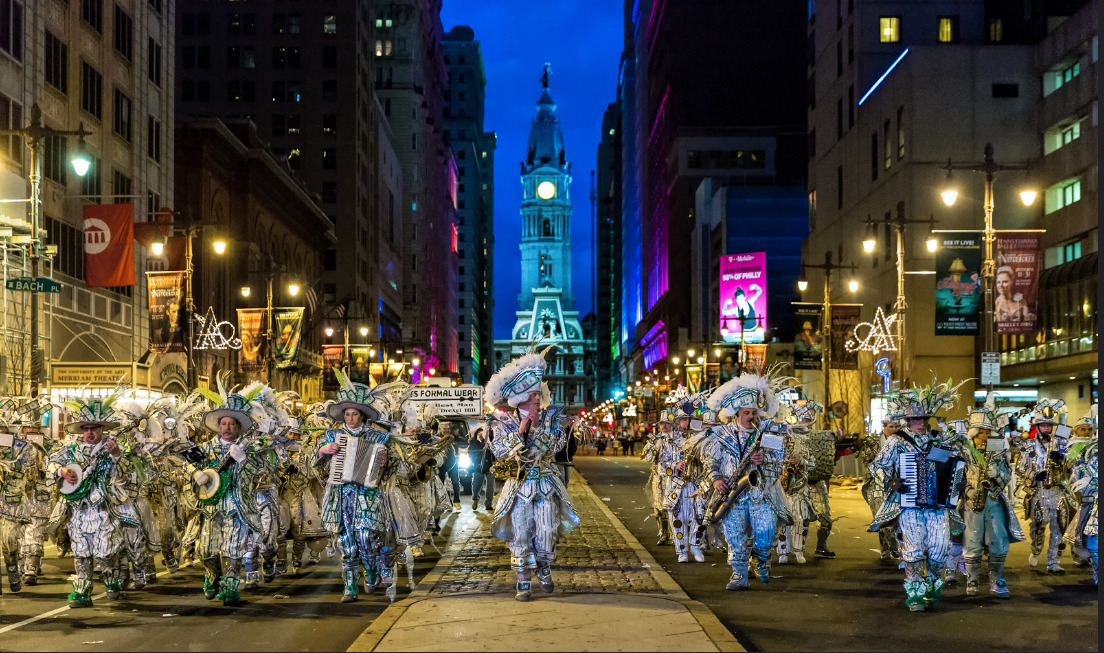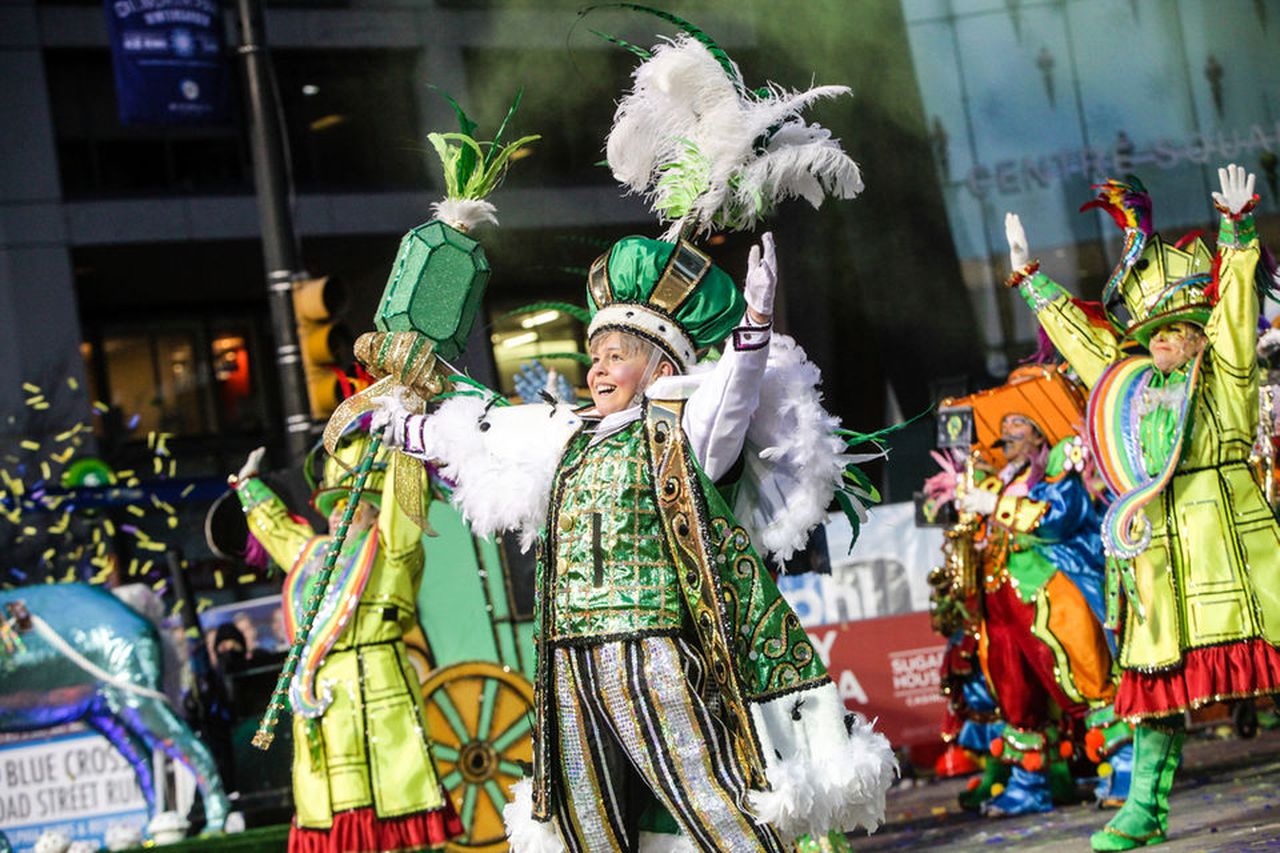The Mummers and Their Strong Relationship With Halloween
 Mummers Parade in Philadelphia in 2020. Mummers Parade in Philadelphia in 2020.
There are many people, in various Western nations, who practise mummering. Mummering involves, during the snowy season, to dress up in strange looking costumes with big masks, hoods so that people do not know who is underneath. Just like Halloween where young people disguise themselves in highly fanciful; outlandish costumes during the last day of October (the 31st) which heralds the start of the snowy month of November to late March Springtime; European mummers in their disguises, during the winter festivals, paraded the streets and entered houses they were welcomed into to dance or play dice in solitary. In ancient times, mummers thought that by wearing their highly unusual costumes and through their swaying movements that they would be able to contact supernatural entities; nature spirits to help the people to endure harsh winters, have enough food, and help crops that grow in the winter to continue to grow.
Eventually, the mummers adopted a ritual in which one of their costumed members would seem to be killed off by another member or members, but then brought back to life by a doctor or person with supernatural healing powers. This whole ritual was based on the sun, with its light and warmth, that can seem to die during the bleak of winter; only to always continue to come back. The death and resurrection ritual of the sun, over many centuries was changed to become a play where the costumed characters represent humans and the sun becomes a champion, the killer is a villian, and the “doctor” a hero. That play is called “the mummers’ play” and still is performed in a few villages in England and Northern Ireland.

The mummers would also perform other “plays” that center on frolicing, acting silly, being humorous, being statrical of others, especially important people, being controversial, while using a lot of physical energy in their performances. Some lady mummers would act sexy.The word “Mummer” has been traced back to ancient Greece. The word is derived from “Momus”. the personification of satire and mockery. Mummer is also found in an old English word “mommer” that relates to miming, masking, and mockering.
As the many years rolled along, mummers would ask for donations after they performed their outdoors dances, ceremonies, and oratories, including reciting poetry or telling short stories. Mummers who entered private homes to perform would ask for food and/or drink either silently with their hands or in a clear voice. Like Halloween centuries ago, mummers would ask for food and some mummers asked for a drink. A famous old Mummer’s poetic plea or ballad is as follows: “Here we stand before your door, as we stood the year before, give us whiskey, give us gin, open the door, and let us in.”Mummers still go into people’s houses for alcohol and/or soup, but now the mummers only enter homes that have their doors open and want their visits.

As centuries went by, the mummers began to become associated with, in Christian countries, Christmas Day and New Year’s Day. People began to fill the streets turning into great crowds all the while expecting to see and hear the mummers perform their masquerade party antics; to be entertained by the mummers. Men, women, and even children have participated in these colorful, robust, sensational outfit wearing performances. Such an action resulted in the “Mummers Parade”.
One of the biggest places for the annual Mummers Parade is Philadelphia, Pennsylvania, USA which held its first official such parade on January 1, 1901 to mark the New Year. The parades of today also feature much singing, and musical instruments playing, An average of 10,000 adults and children are members of the marching parade. About 2,000,000 people watch as spectators and listen to the mummer parade in Philadelphia and its suburbs.
George Washington hosted the Mummers New Year’s Day during his stay in Philadelphia.
Mummers have been in America for well over 3 centuries. In Philadelphia, Pennsylvania, which was the original capital of the United States of America since 1776, since the signed Declaration of Independence document, there were a great many mummers, both European born and raised and American born and raised.
George Washington (1732-1799), who was America’s first official President, from 1789 to 1797, lived in the President’s House right on 6th and Market Street. He is credited with calling upon the Mummers New Year’s Day to celebrate the holiday for all the 7 years he lived in Philadelphia, PA.
In Newfoundland, Canada, there are mummer winter festivals. The mummers go back to Canada since before the early 1800’s. In Ireland, the mummers practiced their fun filled, strange and sometimes outrageously covered clothed apparel, often made of straw, rites for over 400 years. In England mumming goes back over a thousand years. The plays of the mummers are one of the oldest surviving features of the traditional English Christmas.
~~~~~~~~~~~~~~~~~~~~~~~~~~~~~~~~~~~~~~~~~~~~~~~~~~~~~~~~~~~~~~~~~~~~~~~~~~~~~~~~~~~
en.wikipedia.org
For other uses, see Mummering (disambiguation).

2013 St John's Mummers Parade Mummering is a Christmas-time house-visiting tradition practiced in Newfoundland and Labrador, Ireland, Philadelphia, and parts of the United Kingdom.
Also known as mumming or janneying, it typically involves a group of friends or family who dress in disguise and visit homes within their community or neighboring communities during the twelve days of Christmas. If the mummers are welcomed into a house, they often do a variety of informal performances that may include dance, music, jokes, or recitations. The hosts must guess the mummers' identities before offering them food or drink. They may poke and prod the mummers or ask them questions. To make this a challenge for the hosts, the mummers may stuff their costumes, cross-dress, or speak while inhaling ( ingressive speech). Once the mummers have been identified, they remove their disguises, spend some social time with the hosts, and then travel as a group to the next home. [1] [2]
History
An old Christmas custom from England and Ireland, mummering in a version of its modern form can be traced back in Newfoundland into the 19th century. Although it is unclear precisely when this tradition was brought to Newfoundland by the English and Irish, the earliest record dates back to 1819. [3] Some state that the tradition was brought to Newfoundland by Irish immigrants from County Wexford. [4] The tradition varied, and continues to vary, from community to community. Some formal aspects of the tradition, such as the mummers play, have largely died out, with the informal house-visiting remaining the predominant form.
On June 25, 1861, an "Act to make further provisions for the prevention of Nuisances" was introduced in response to the death of Isaac Mercer in Bay Roberts. [5] [6] Mercer had been murdered by a group of masked mummers on December 28, 1860. [7] The Bill made it illegal to wear a disguise in public without permission of the local magistrate. Mummering in rural communities continued despite the passage of the Bill, although the practice did die out in larger towns and cities. [8]
In the 1980s, mummering experienced a revival, thanks to the locally popular musical duo Simani, who wrote and recorded "Any Mummers Allowed In?" (commonly referred to as "The Mummer's Song") in 1982. Folklorist Dr. Joy Fraser has noted that, "in common with many other folk revivals, the resurgence of Christmas mummering in Newfoundland is largely based on a selective and idealised conceptualisation of the custom. As part of this revival, one particular form of mummering - the informal house-visit described above - has come to represent the custom in Newfoundland as a whole, while other forms that were equally prominent in the island’s cultural history have received comparatively little attention." [9]
In 2009, the Heritage Foundation of Newfoundland and Labrador's Intangible Cultural Heritage office established what would become an annual Mummers Festival, culminating in a Mummers Parade in St. John's. [10] [11] [12] [13] [14] The success of the festival has influenced, in part, another revitalization and increase of interest in the tradition in the province. |








